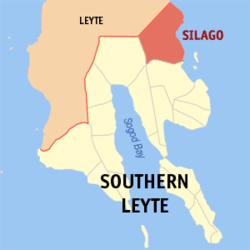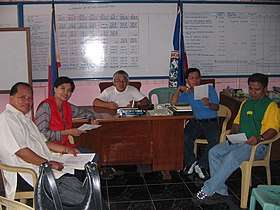Silago, Southern Leyte
Silago, officially the Municipality of Silago (Cebuano: Lungsod sa Silago; Tagalog: Bayan ng Silago), is a 4th class municipality in the province of Southern Leyte, Philippines. According to the 2015 census, it has a population of 12,775 people. It used to be barrio of Hinunangan until Executive Order No. 326 dated May 17, 1951 separated it from the mother town. The town has an ebony beach with unique black sand.[5]
Silago | |
|---|---|
| Municipality of Silago | |
 | |
 Seal | |
| Motto(s): Kalimpyo + Kahimsug + Kalinaw = Kalambuan (3K's=1K) | |
| Anthem: Silago Hymn | |
 Map of Southern Leyte with Silago highlighted | |
OpenStreetMap 
| |
.svg.png) Silago Location within the Philippines | |
| Coordinates: 10°31′45″N 125°09′42″E | |
| Country | |
| Region | Eastern Visayas (Region VIII) |
| Province | Southern Leyte |
| District | 2nd District |
| Founded | June 20, 1950 |
| Barangays | 15 (see Barangays) |
| Government | |
| • Type | Sangguniang Bayan |
| • Mayor | Pacita T. Almine |
| • Vice Mayor | Lemuel P. Honor |
| • Congressman | Roger G. Mercado |
| • Electorate | 9,700 voters (2019) |
| Area | |
| • Total | 215.05 km2 (83.03 sq mi) |
| Population (2015 census)[3] | |
| • Total | 12,775 |
| • Density | 59/km2 (150/sq mi) |
| • Households | 3,096 |
| Economy | |
| • Income class | 4th municipal income class |
| • Poverty incidence | 41.67% (2015)[4] |
| • Revenue (₱) | 70,113,414.97 (2016) |
| Time zone | UTC+8 (PST) |
| ZIP code | 6606 |
| PSGC | |
| IDD : area code | +63 (0)53 |
| Climate type | tropical rainforest climate |
| Native languages | Boholano dialect Cebuano Tagalog |
Barangays
Silago is politically subdivided into 15 barangays.
- Balagawan
- Catmon
- Hingatungan
- Imelda
- Katipunan
- Laguma
- Mercedes
- Poblacion District I
- Poblcaion District II
- Puntana
- Salvacion
- Sap-ang
- Sudmon
- Tuba-on
- Tubod
Demographics
|
| |||||||||||||||||||||||||||||||||
| Source: Philippine Statistics Authority [3][6][7][8] | ||||||||||||||||||||||||||||||||||
Climate
| Climate data for Silago, Southern Leyte | |||||||||||||
|---|---|---|---|---|---|---|---|---|---|---|---|---|---|
| Month | Jan | Feb | Mar | Apr | May | Jun | Jul | Aug | Sep | Oct | Nov | Dec | Year |
| Average high °C (°F) | 28 (82) |
28 (82) |
29 (84) |
30 (86) |
30 (86) |
30 (86) |
29 (84) |
30 (86) |
30 (86) |
29 (84) |
29 (84) |
28 (82) |
29 (84) |
| Average low °C (°F) | 22 (72) |
22 (72) |
22 (72) |
23 (73) |
24 (75) |
24 (75) |
24 (75) |
24 (75) |
24 (75) |
24 (75) |
23 (73) |
23 (73) |
23 (74) |
| Average precipitation mm (inches) | 90 (3.5) |
67 (2.6) |
82 (3.2) |
70 (2.8) |
97 (3.8) |
145 (5.7) |
142 (5.6) |
127 (5.0) |
132 (5.2) |
152 (6.0) |
169 (6.7) |
144 (5.7) |
1,417 (55.8) |
| Average rainy days | 17.0 | 13.5 | 16.0 | 16.5 | 20.6 | 24.3 | 26.0 | 25.4 | 25.2 | 26.4 | 23.0 | 21.1 | 255 |
| Source: Meteoblue [9] | |||||||||||||
Etymology
The name "Silago" was a shortening of Spanish murcielago ("bat"), referring to an account when the Spaniards encountered bats in the area perching in trees locally known as tuog. The natives replied the incomprehensible question of the name of their place asked by the Spaniards saying "tua'y daghang kabug" in the belief that the Spaniards were amazed the huge number of bats present in the area that time. The place was then called "Murcielago" and over time, was shortened to its present name Silago.
However, accounts from Pigafetta on the Magellan voyage indicates a certain island in Leyte recorded as 'Cenalo' along with the recorded 'Hinnangar' (Hinunangan), and 'Abarien' (Cabalian), which in a new presentation by Greg Hontiveros on the First Mass controversy published in 2008, designated it to the Hingatungan Point in the town and therefore not an island as the account indicates.
History
Silago was once part of the Municipality of Hinunangan, located in the northernmost part of the said town. For several years, Silago was under the political jurisdictions of Hinunangan, even during World War I and II.
During World War II, Silago was chosen as the site of submarine landing of American military arms and equipment for the Leyte guerillas. The military hardware was efficiently moved to Leyte by hundreds of volunteer guards under the Leyte area command of Col. Ruperto K. Kangleon.[10]
After the Second World War, Silago became more progressive and had increased its population, and thus became the biggest barangay of Hinunangan. Progress served as pushing factor that Silago has availed and gained qualifications to become a municipality.
In 1948, the Secretary of National Defense Ruperto Kangleon worked hard for the conversion of barrio Silago to a municipality. Finally on June 20, 1950, the new Municipality of Silago was inaugurated by virtue of an Executive Order No. 326 issued by President Elpidio Quirino. Such Executive Order was chartered through Republic Act No. 5962 "Creating the Municipality of Silago in the Province of Southern Leyte" on June 21, 1969.
This was made possible also through the invaluable services and voluntary effort extended by the late Canuto Capapas and Apolonio A. Lucero. These two Silagonhons even donated real properties as lands to meet the requirements of becoming a municipality.

The first set of Municipal Officials were appointed by President Elpidio Quirino on May 17, 1951. It was headed by Felix Balagon as Municipal Mayor, Leon Fortaliza as Vice Mayor, Manuel Tomol, Enrique Sarona, Modesto Miras and Manuel Cruzada as councilors.Mr. Pedro Tomol was appointed as Municipal Secretary.
Natural attractions
Silago got her name from the word “murcielago” which is a Spanish term for bat, because of this species' dominance in the locality. Proof to this is the giant bat sanctuary at Barangay Catmon. Along the coastal barangays of the town, there are clean beaches and a structure designed by nature lying in the town's deep blue sea known as Pelada Rock, also locally known as “Batong Dako" meaning large rock, which was occupied and utilized as a camp by the Japanese Imperial Army during the Second World War. The peculiar beauty of this rock is enhanced with the abundance of birds hovering and built their nest on it, sea snakes making the rock as their dwelling place, with fish and other marine products surrounding it. The rock is located just a short distance from the shore of Barangay Laguma and Barangay Salvacion.
Farther north, is a natural rock formation with a length of more or less 50 meters from the shore and about 10 meters wide.
The interior of Silago is mountainous, in which is the town's vast forest, home of the wild pigs locally known as “Baboy Ihas”. Among all the municipalities of the province, Silago is identified to have the biggest forest area.
The municipal tree park is another kind of tourist attraction in the municipality where fresh breeze and songs of the birds make the atmosphere pleasantly unique. On its northern part is a clean and clear river suitable for swimming.
In the upper portion of the town, at different locations, are waterfalls. Kagut-an falls is more or less 1 kilometer away from the national highway, at Barangay Katipunan. This falls is paired with another falls near its vicinity, locally called as Kagut-an Dako Dos Falls, which possesses an exceptional attraction to all who sees it. In the same barangay is another falls called Kagut-an Gamay falls. In Barangay Mercedes, about 1 kilometer distance from Mercedes Barangay Road, is Sitio Kawayan Falls with a height of about 10 meters.
Another falls is in Barangay Tubod distinctive in structure with matching cave on its opposite side. Water from this falls, along its way meets the Lanang River flow, which also has its own unique attraction.
Aside from Lanang River, which is located at the town's mountain barangay, is the Maag River that crosses along the national highway in Poblacion District 1. This river forms a lake that is suited for boating recreation. At the mouth of the river is the brown fine sand beach of Silago, which is more or less 1 kilometer long.
In the months of November to February, Silago's beaches are ideal for surfing with huge sea waves, comparable to waves in Siargao.
Town Hymn
Silago Hymn
O, lungsod kong mahal ikaw akong ampingan
Tuburan sa kinabuhi sa mga lumulupyo
Ikaw ang pag-laum nga nagagikan sa sidlakan
Ikaw akong pangga-on ug akong mahalon
Silago, Silago, buot ako nga magpabilin kanimo
Ang imong katahom gakson ko hangtud sa kahangturan
Himuon ko ang tanan alang kanimo lungsod ko
Kay ikaw ang gimat-an ko minahal nga yuta
Kalimpyo, kahimsug ug kalinaw, mao ang dalan sa Kalambuan
Ug kining akong kinabuhi ihalad ko kanimo Silago
Luha sa kagul-anan modagayday kung ikaw pasipad-an
Kalipay og katawa ang matagamtaman
Kung ang bidlisiw sa kalampusan makit-an
Silago, Silago, matin-aw pa ang suba sa paglaum
Malunhaw pa gihapon ang tanaman sa kabukiran
Ang balod sa kadagatan may panahon pa sa iyang paglurang
O, Silago, ikaw ang lungsod kong mahal
O, Silago, ikaw ang lungsod kong mahal
Written and composed by: Rev. Fr. Plutarco Rodriguez and Neil Mate
Implemented by: Mayor Martin “Boy” Tomol Sr.
Education
Elementary schools:[11]
Almost all barangays have Elementary / Primary Schools, few are mentioned below:
- Silago Central Elementary School - Barangay Poblacion District I
- Sudmon Elementary School - Barangay Sudmon
- Hingatungan Elementary School - Barangay Hingatungan
- Awayon Elementary School - Barangay Mercedes
High schools:[12]
- Silago National Vocational High School - Barangay Poblacion District II
- Hingatungan National High School - Barangay Hingatungan
- Mercedes National High School - Barangay Mercedes
- Katipunan National High School - Barangay Katipunan
References
- "Municipality". Quezon City, Philippines: Department of the Interior and Local Government. Retrieved 31 May 2013.
- "Province: Southern Leyte". PSGC Interactive. Quezon City, Philippines: Philippine Statistics Authority. Retrieved 12 November 2016.
- Census of Population (2015). "Region VIII (Eastern Visayas)". Total Population by Province, City, Municipality and Barangay. PSA. Retrieved 20 June 2016.
- "PSA releases the 2015 Municipal and City Level Poverty Estimates". Quezon City, Philippines. Retrieved 12 October 2019.
- ___________. "Silago". www.southernleyte.gov.ph. Retrieved 2016-04-28.CS1 maint: numeric names: authors list (link)
- Census of Population and Housing (2010). "Region VIII (Eastern Visayas)". Total Population by Province, City, Municipality and Barangay. NSO. Retrieved 29 June 2016.
- Censuses of Population (1903–2007). "Region VIII (Eastern Visayas)". Table 1. Population Enumerated in Various Censuses by Province/Highly Urbanized City: 1903 to 2007. NSO.
- "Province of Southern Leyte". Municipality Population Data. Local Water Utilities Administration Research Division. Retrieved 17 December 2016.
- "Silago, Southern Leyte : Average Temperatures and Rainfall". Meteoblue. Retrieved 13 January 2019.
- ___________. "Silago". www.southernleyte.gov.ph. Retrieved 2016-04-28.CS1 maint: numeric names: authors list (link)
- http://www.philippinecompanies.com/townlist/silago/southern-leyte/schools/13/?&start=10
- http://www.philippinecompanies.com/townlist/silago/southern-leyte/schools/13/?&start=10
External links
| Wikimedia Commons has media related to Silago, Southern Leyte. |